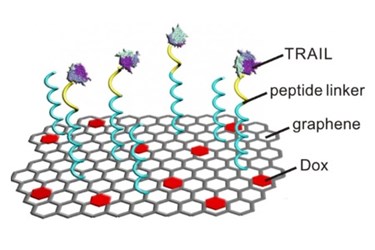Graphene "Flying Carpet" Gives Cancer Therapeutics A Lift
By Chuck Seegert, Ph.D.

North Carolina State University researchers have led an international team in the development of a novel drug delivery technique. The graphene “flying carpets” can be used as blood-borne devices that deliver two types of chemotherapy to tumor cells, applying the therapy to specific areas to achieve maximum effectiveness. Tested in a mouse model, the treatment method has produced a synergistic effect against human lung tumors.
Targeted delivery of chemotherapy is a critical part of cancer research. By exploiting differences between cancer cells and healthy cells, the therapies are specifically focused on the diseased tissues, thus sparing the healthy tissues. Healthy tissues are often negatively impacted by these chemicals, which causes serious side effects. One exploitable difference between healthy tissue and tumors is related to the integrity of the vasculature, which is much higher in normal tissue. Tumors, on the other hand, exhibit leaky vasculature, which allows nanoparticles to pass through the vessel walls.
Utilizing this difference, a team from North Carolina State University (NC State) has developed a novel delivery approach, according to a recent article from NC State News. The team bound two different types of therapeutic drugs to the surface of small strips of graphene. Doxorubicin (DOX), a drug that acts in the nucleus, was attached to the surface of the graphene molecules through similarities of the drug to the chemistry of the graphene. Another drug called TRAIL (tumor necrosis factor-related apoptosis-inducing ligand) acts at the surface of the cell and was bound to graphene using peptide chains. The drug-laden graphene was then injected into the blood stream, where it circulates through the body and localizes to the tumor.
“These drug-rich graphene strips are introduced into the bloodstream in solution, and then travel through the bloodstream like nanoscale flying carpets,” said Dr. Zhen Gu, an assistant professor in the joint biomedical engineering program at NC State and UNC-Chapel Hill, in the article.
The goal of the new approach was to have each drug released sequentially at its most desirable site — the nucleus for DOX and the cellular surface for TRAIL, according to a recent study published by the team in Advanced Materials. When the flying carpet contacts the cell, TRAIL is bound to its surface and then severed from the graphene by enzymes that cut the peptide tether, according to the article. Once this is complete, the graphene is no longer tied to TRAIL and can be ingested into the cell, where DOX is released and attacks the tumor’s DNA.
The graphene flying carpets were pre-clinically tested in mice using the lung cancer tumor cell line A549, according to the article. When flying carpets had both drugs, they were shown to be much more effective than when each drug was delivered alone.
Additionally, the release of the drug from graphene was also shown to be important. When the drugs were tightly tethered so that they couldn’t be cleaved from the graphene, their effectiveness dropped.
Use of graphene for drug delivery is a research focus for other teams as well. For example, exposing graphene sheets to a magnetic field causes them to form spherical droplets. These droplets are currently being investigated as a potential drug-releasing device.
Image Credit: Zhen Gu
